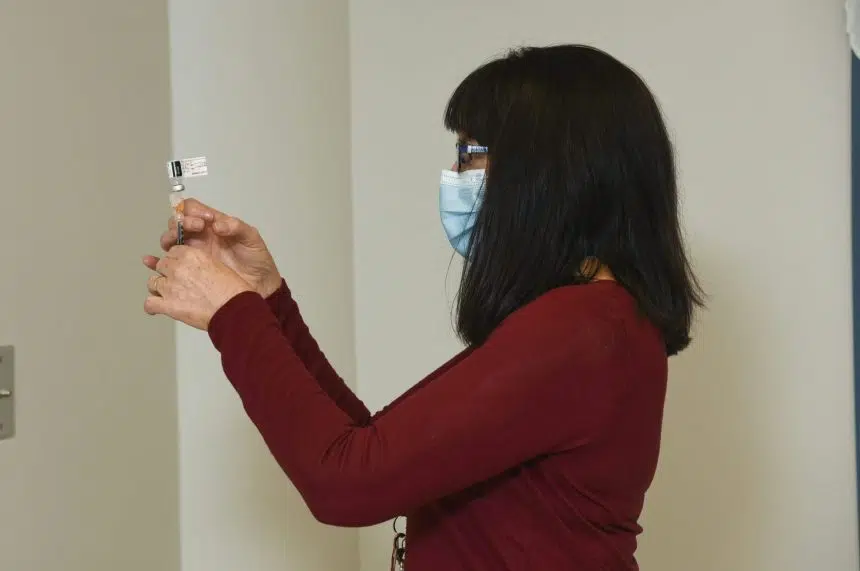The Saskatchewan government laid out Phase 2 of its COVID-19 vaccination plan Tuesday, even though the end date for Phase 1 is unclear.
“I’ve heard from a lot of people who want to know what’s going on, what is it going to look like, how are we going to be informed and when can we get in,” Health Minister Paul Merriman said during a media conference.
“We’re trying to give them two out of three of that, with what is it going to look like with the mass vaccination clinics, the drive-throughs and also the mobile clinics. We’re going to tell them how they can do this.
“The when is a little bit out of our hands right now. Well, it’s not a little bit; it’s completely out of our hands. That’s when the vaccines actually start flowing.”
Recent delays in the delivery of vaccines have slowed Phase 1, in which residents and staff at long-term and personal care homes, and health-care workers in emergency departments, intensive care units and COVID wards were among those getting their shots.
According to the government, the shortage of vaccines caused by a production slowdown at the Pfizer plant could reach more than 12,600 doses by the end of March. As a result, the province may not be able to vaccinate as many people as it had hoped in the first quarter of 2021.
But the government wants to be prepared for Phase 2, which would see the general population start to receive doses in April if vaccine supplies are adequate.
“Although we’ve seen this delay, which has slowed us down in Phase 1 and potentially is going to impact Phase 2, what it also does is give us time to create that all-hands-on-deck (approach) …” Scott Livingstone, CEO of the Saskatchewan Health Authority, said in reference to the plan to deliver shots using multiple resources.
“Once vaccines start shipping, if it starts shipping in larger quantities than we expect, we’ll be prepared to be able to deliver that to the people of this province at a quicker pace.”
The government’s plan — which can be seen below — will do inoculations in 10-year increments, starting with those between the ages of 60 and 69.
The province pointed to the number of COVID-related fatalities and hospitalizations as proof that age and risk factors are the biggest issues driving its plan. The 80-and-over age group has the highest-such numbers and the statistics drop as ages drop.
Merriman said he heard from groups who asked for their members to be inoculated as quickly as possible and said all of their points were valid. However, basing the schedule on age was the province’s choice.
“What we’re looking at right now is getting a large quantity of vaccines in a short amount of time,” Merriman said. “The best way to distribute that and get it across our province as fast as possible and as safe as possible is to look at age categories. That’s also where we’ve seen the attack rate of COVID.”
Merriman said those 60 and older have had the worst outcomes in the pandemic, so the goal is to get them vaccinated and take some pressure off the health-care system “and hopefully at some point we can start looking at what are the restrictions we can do once that group is protected.”
The government said there are 138,472 residents in the 60-to-69 age group across the province, 147,469 people aged 50 to 59, 151,901 individuals from age 40 to 49, 183,292 people in the 30-to-39 age group, and 190,043 people aged 18 to 29.
Other priorities in Phase 2 are residents and staff of emergency shelters and group homes for persons with intellectual disabilities, as well as clinically extremely vulnerable adults.
How the rollout happens depends on vaccine supplies.
If the government uses what it calls “the high-range scenario” with the vaccine supplies it expects to receive, doses would be exhausted by late June. If more supplies are received, vaccinations could be finished by the fourth week of July.
The health authority is planning to operate 226 vaccine clinics in 181 communities around the province, not including clinics that are to be established in First Nations communities.
There are to be 141 mass immunization clinics, 24 drive-through immunization clinics, and 61 mobile clinics.
As well, the government has reached an agreement with the Pharmacy Association of Saskatchewan, meaning vaccinations can be provided at the 410 pharmacies in nearly 130 communities in Saskatchewan.
Livingstone said the SHA-operated clinics won’t require a shifting of resources, as the authority has been preparing for this.
“We’re not using the same resources twice,” he said. “We’ve been building a labour pool to support our actions. We continue to build a labour pool specific to immunization and we will be drawing on some non-traditional individuals to join us in immunizing residents across the province …
“Those people (who) can actually put in the needle in arms? That’s what they’re doing; they’re putting the needle in the arm. They’re not directing traffic, they’re not managing the line (and) they’re not managing the administrative responsibilities associated with it.”
Clinic locations and times are to appear at www.saskatchewan.ca/COVID19-vaccine. Residents also will be able to call 811 to book appointments. An online scheduling system is to start on www.saskatchewan.ca in March.
Residents will be provided with pertinent information through the mail, on social media, via public service announcements, in television and radio advertisements, and online.
They’ll be told when it’s their turn to get vaccinated, how to register for an appointment, what kinds of clinics are available, and how to find the closest clinics.
“Saskatchewan is working to vaccinate as many people as quickly as possible,” Merriman said in a media release. “The commencement of mass vaccinations will depend on the number and consistency of vaccine deliveries from the federal government.”











